Breda,Province of North Brabant, Netherlands 作者: 来源: 发布时间:2021-02-22
一、人口,面积,所属地区

Location in North Brabant
Country Netherlands
Province North Brabant
Area
• Municipality 128.68 km2 (49.68 sq mi)
• Land 126.04 km2 (48.66 sq mi)
• Water 2.64 km2 (1.02 sq mi)
Population (Municipality, January 2019; Urban and Metro, May 2014)
• Municipality 183,873
• Density 1,459/km2 (3,780/sq mi)
• Urban 180,420
• Metro 324,812
• Metro region [nl] 553,706
• Brabant CMSA 1,932,055
Demonym(s) Bredanaar, Bredaër
Postcode
4800–4841, 4847, 4850–4854
Area code 076
Website www.breda.nl
Breda is a city and municipality in the southern part of the Netherlands, located in the province of North Brabant. The name derived from brede Aa ('wide Aa' or 'broad Aa') and refers to the confluence of the rivers Mark and Aa.
As a fortified city, it was of strategic military and political significance. Although a direct Fiefdom of the Holy Roman Emperor, the city obtained a municipal charter; the acquisition of Breda, through marriage, by the House of Nassau ensured that Breda would be at the centre of political and social life in the Low Countries. Breda had a population of 183,873 in 2019; the metropolitan area had a population of 324,812. It is part of the Brabantse Stedenrij.
二、自然地理
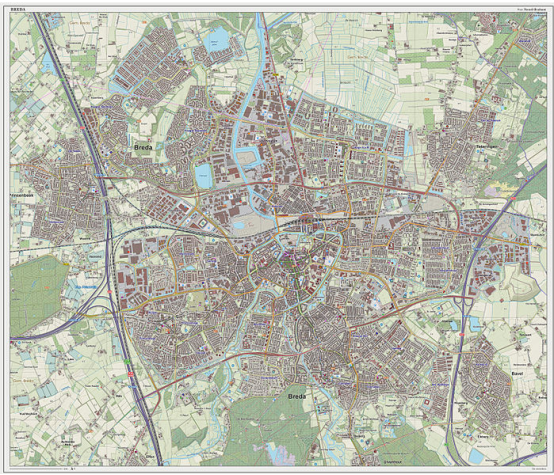
Topographic map image of the city of Breda, March 2014. Click to enlarge.
Religion
As of 2014, the largest religion in Breda is Christianity, comprising 50.4% of its population, the second one being Islam comprising 3.6% of the population. Unaffiliated people comprised 44.9% of the population.
Ethnic groups
The ethnic make-up of Breda, in 2018, is as follows:
Dutch (140,312) (76.5%)
Moroccans (5,712) (3.1%)
Indonesians (5,332) (2.9%)
Turks (3,080) (1.7%)
Belgians (2,940) (1.6%)
Germans (2,661) (1.5%)
Antilleans/Arubans (2,211) (1.2%)
Polish (2,165) (1.2%)
Surinamese (2,058) (1.1%)
Transportation
Trains
Breda has two railway stations, Breda and Breda-Prinsenbeek, providing connections north to (Dordrecht, Rotterdam, Den Haag) and Amsterdam; east to Tilburg, Eindhoven, Den Bosch, Nijmegen and Zwolle; west to Roosendaal and Vlissingen and south to Antwerp and Brussels (via the HSL-Zuid high-speed line). Breda Oost railway station will open after 2020.
Roads
The A16 is a motorway to the north to Rotterdam and towards the south to the Belgian border to Antwerp. The A27 is also a motorway to the north; It connects Breda with Utrecht. Furthermore, The A58 connects Breda with Tilburg and Eindhoven.
Buses
Buses are operated by Arriva. There are four kinds of buses in Breda: citybuses, regional, Volans and long-distance. Citybuses drive only within Breda (sub-12 numbers), regional buses provide connections to nearby towns and cities, Volans buses are more luxurious buses driving to Etten-Leur and Oosterhout (31x and 32x-buses), and long-distance 'Brabantliners' connecting both Gorinchem and Utrecht with Breda (401, 402). There is also one Zeelandish busline which connects Breda with Hulst and Antwerp, operated by Connexxion.
三、经济发展和规模

四、产业特点/重点项目
Historically, economic activities were mainly industrial. Breda was a center of the food- and drink industry. Companies like Hero (lemonade), Van Melle (Mentos), De Faam (liquorice) and Kwatta (chocolate) are famous throughout Western Europe. Breda also had a sugar factory, supplying its best-known products.
Breda formerly housed the largest brewery in the Netherlands (Oranjeboom). The multinational Interbrew took over the brewery in 1995 and then closed it in 2004. Production of the Breda brand was moved to both Bremen and Leuven until 2008, when Randalls Brewery (in Guernsey) acquired the licence. Guernsey is now the only place in the world where draught Breda is brewed.
However, the decline of industrial activity did not harm the city's economy. Nowadays, Breda is a service oriented economy based on business, trade and logistics. A growing number of international companies choose to establish their head office for Benelux operations in Breda. Examples of these companies are Abbott Laboratories, General Electric, ExxonMobil, Texaco, Scania, Dockwise, Toshiba, Alfa Laval, Krohne Oil & Gas, General Motors, Ritchie Bros. Auctioneers and Amgen. Also, the food industry is still largely represented by companies such as Hero Group, Perfetti Van Melle, Anheuser-Busch InBev and Royal Cosun. Furthermore, the city is host to the headquarters of the Royal Netherlands Air Force. Because of its central location between the ports of Antwerp and Rotterdam, the city also attracts logistics companies. Koch Media has its Benelux office in Breda.]
The main shopping areas of Breda are the city centre and the southern part of Breda. Known shopping centres are De Barones and 't Sas. Major shopping streets are the Eindstraat, Ginnekenstraat [nl], Wilhelminastraat and Ginnekenweg. A market is held on the Grote Markt every Tuesday and Friday from 09:00 to 13:00. A book and antique market is held on Wednesday from 09:00 to 17:00.
五、风景名胜,景点
The city center contains old buildings and portions of the singels (moats) and the harbour. Focal point is the Grote Markt, the main square with pubs and sidewalk cafes.
Park Valkenberg is a major public park, halfway between the main railway station Breda and the Grote Markt.
Major historic buildings include:
The Grote Kerk (Great Church) or Onze Lieve Vrouwe Kerk (Church of Our Lady), a major example of the Brabant style of Gothic Architecture.
The Castle of Breda.
The Begijnhof, a Beguinage.
Saint Anthony's Cathedral (Sint-Antoniuskathedraal), the cathedral church of the Catholic Diocese of Breda.
A moat is a deep, broad ditch, either dry or filled with water, that is dug and surrounds a castle, fortification, building or town, historically to provide it with a preliminary line of defence. In some places moats evolved into more extensive water defences, including natural or artificial lakes, dams and sluices. In older fortifications, such as hillforts, they are usually referred to simply as ditches, although the function is similar. In later periods, moats or water defences may be largely ornamental. They could also act as a sewer.
Park Valkenberg is a major public park, halfway between the main railway station Breda and the Grote Markt.
Major historic buildings include:
The Grote Kerk (Great Church) or Onze Lieve Vrouwe Kerk (Church of Our Lady), a major example of the Brabant style of Gothic Architecture.
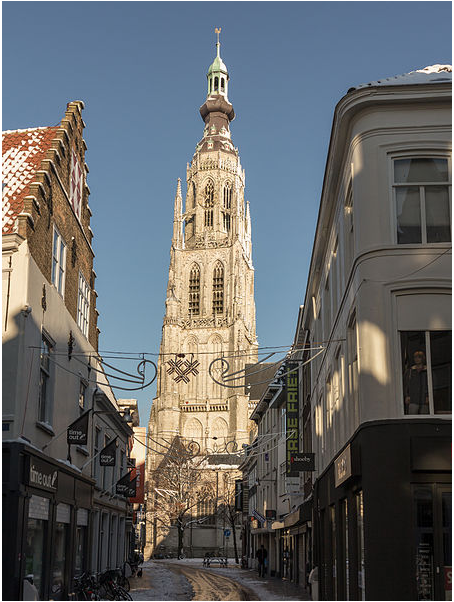
Grote kerk
Grote of Onze-Lieve-Vrouwekerk
"Onze Lieve Vrouwekerk"
The Grote Kerk or Onze-Lieve-Vrouwekerk (Church of Our Lady) is the most important monument and a landmark of Breda. The church is built in the Brabantine Gothic style. The tower of the church is 97 meters tall. The plan is in the shape of a Latin Cross.
The Castle of Breda.

Castle of Breda, Beschryving der stadt en lande van Breda (The Hague 1744)
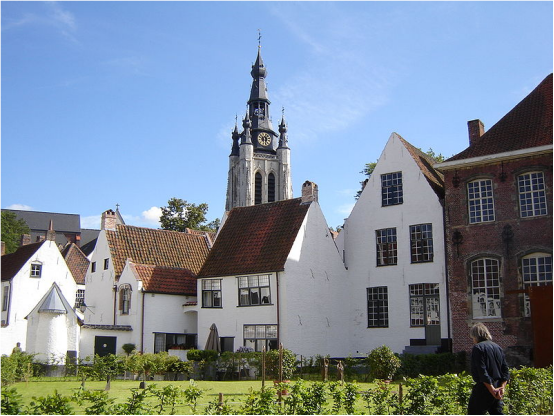
View of the Beguinage in Kortrijk
A beguinage, from the French term béguinage, is an architectural complex which was created to house beguines: lay religious women who lived in community without taking vows or retiring from the world.
Originally the beguine institution was the convent, an association of beguines living together or in close proximity of each other under the guidance of a single superior, called a mistress or prioress. Although they were not usually referred to as "convents", in these houses dwelt a small number of women together: the houses small, informal, and often poor communities that emerged across Europe after the twelfth century. In most cases, beguines who lived in a convent agreed to obey certain regulations during their stay and contributed to a collective fund.[1]
In the first decades of the thirteenth century much larger and more stable types of community emerged in the region of the Low Countries: large court beguinages were formed which consisted of several houses for beguines built around a central chapel or church where their religious activities took place; these often included functional buildings such as a brewery, a bakery, a hospital, some farm buildings. Several of these beguinages are now listed by UNESCO as World Heritage sites. Around the mid-thirteenth century, the French king Louis IX founded a beguinage in Paris, which was modeled on the court beguinages of the Low Countries.
The Koepelgevangenis in 2008
The Koepelgevangenis is a former prison in Breda, Netherlands, constructed in 1886, best known as the prison where convicted World War II collaborators were held captive.
六、历史文化
In the 11th century, Breda was a direct fief of the Holy Roman Emperor,[7] its earliest known lord being Henry of Brunesheim (1080–1125). The city of Breda obtained a municipal charter in 1252. After that Breda had the rights to build fortifications. The city constructed brick walls and Roman-style gates.
In 1327, Adelheid of Gaveren sold Breda to Duke Johannes III of Brabant. In 1350, the fief was resold to Johannes II of Wassenaar (d. 1377). In 1403, the heiress of his line, Johanna of Polanen (1392–1445), married Engelbert I of Nassau (1370–1442; his sarcophagus is in the Grote Kerk in Breda). Through her, the city came into the possession of the House of Nassau, where it remained until 1795, passing to William I of Orange (1533–1584), stadtholder of Holland, Zeeland, and Utrecht and leader of the Dutch revolt. Thus, the baron of Breda was also Count of Nassau in the Holy Roman Empire, Prince of Orange, and (the main) stadtholder in the Dutch Republic (from 1572–1650, 1672–1702, 1747–1795). Breda remained part of the barony of Breda until it was captured by French revolutionary forces in 1795.
Residence city
The acquisition of the city by the House of Orange-Nassau marked its emergence as a residentiestad (residence city). The presence of the Orange-Nassau family attracted other nobles, who built palatial residences in the old quarters of the city. The most impressive one, built by the Italian architect Thomas Vincidor de Bologna for the first Dutch prince, was the first renaissance-style palace built north of the Alps. In the 15th century the city's physical, economic and strategic importance expanded rapidly. A great church was built in Brabantine Gothic style with a gallant 97-metre-high (318 ft) tower, called Grote Kerk (main church) or also Onze Lieve Vrouwe Kerk (Church of Our Lady). In 1534 Henry III of Nassau-Breda rebuilt the modest medieval fortifications in impressive style.
In 1534 a fire destroyed over nine tenths of the city, close to 1300 houses, churches, and chapels, and the town hall. Only 150 houses and the main church remained. In July 1581, during the Eighty Years' War, Breda was captured in a surprise attack and siege by Spanish troops then under the command of Claudius van Barlaymont, whose sobriquet was Haultpenne. Although the city had surrendered upon the condition that it would not be plundered, the troops vented their fury upon the inhabitants. In the resulting mayhem, known as Haultpenne's Fury, over 500 citizens were killed. In March 1590, Breda fell back into the hands of the Dutch and Maurice of Nassau, when a 68 men hand-picked force, concealed under the turf of a peat-boat, had contrived to enter the city in a daring plan devised by Adriaen van Bergen (Siege of Breda (1590)). Around 1610 the construction of the Spanish Gate or "Spandjaardsgat" was started as a remembrance to that successful action.
Haultpenne's soldiers vent their fury upon the citizens of Breda in 1581
After a ten-month siege in 1624–25, the city again surrendered to the Spaniards, now led by Spinola; the event was immortalized by Diego Velázquez. In the Siege of Breda of 1637 the city was recaptured by Frederick Henry, Prince of Orange, after a four-month siege, and in 1648 it was finally ceded to the Dutch Republic by the Treaty of Westphalia.
In 1646, Frederick Henry founded the Orange College of Breda, modelled on Saumur, Geneva, and Oxford, intending it to train young men of good family for the army and the civil service.
Stuart exiles
The exiled Stuart Charles II of England resided in Breda for a little over a month of his time in exile during the Cromwellian Commonwealth and Protectorate, thanks to the proximity of Charles's sister Mary, Princess Royal and Princess of Orange, the widow of Prince William II of Orange (died 1650).
Based mostly on suggestions by the Parliamentarian General George Monck, Charles II's Declaration of Breda (1660) announced his conditions for accepting the crown of England, which he was to regain a few months later in the year.
Later history
The Treaty of Breda was signed in the city on 31 July 1667, bringing to an end the Second Anglo-Dutch War in which the Dutch faced the same Charles II who had been their guest. Between 1746 and 1748 it was the site of the Congress of Breda, a series of talks between Britain and France aimed at bringing an end to the War of the Austrian Succession, which ultimately led to the signing of the Treaty of Aix-la-Chapelle.
During the Second World War, the city was under German occupation for over four years. During Operation Pheasant Breda was liberated following a successful outflanking manoeuvre planned and performed by forces of 1st Polish Armoured Division of General Maczek on 28 October 1944. Each year during Liberation Day festivities, Breda is visited by a large Polish contingent and the city of Breda reserves a special portion of the festivities for the fallen Polish soldiers. A museum and a monument honoring Maczek and the Polish 1st Armoured Division stands in the city center. General Maczek and many soldiers of his division are buried in the nearby Polish military cemetery.
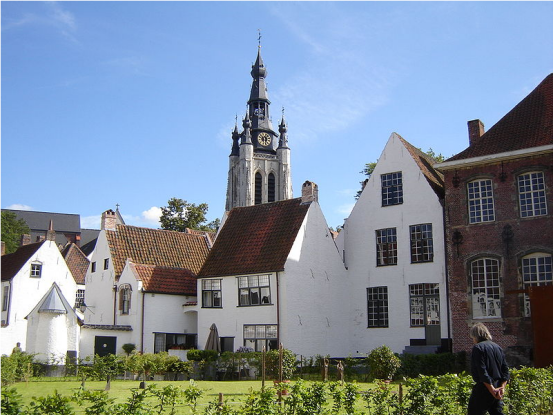
Breda, Polish chapel
Breda was the site of one of the first panopticon prison establishments, Koepelgevangenis. This prison housed the only German war criminals ever to be imprisoned in the Netherlands for their war crimes during the Second World War. Known as the Breda Four, or "Vier von Breda", they were Willy Paul Franz Lages, who was released in 1966 due to serious illness, Joseph Johann Kotälla, who died in prison in 1979, and Ferdinand aus der Fünten and Franz Fischer, who were both released in 1989 and died later the same year.
Culture
The spoken language is West Brabantian, which is very similar to colloquial Dutch.
Musical events are held in the Chasse Theater.
Redhead Day was a festival that took place each first weekend of September. The two-day festival is a gathering of people with natural red hair, but is also focused on art related to the colour red. Activities during the festival are lectures, workshops and demonstrations. The festival attracts attendance from 20 countries and was free due to sponsorship of the local government. Furthermore, some people referred to Breda as the opposite of burning man. As the festival grew bigger they needed a new spot to host the ever growing event. Since 2019 the festival relocated to Tilburg.
Museums
Breda hosts the following museums:
Begijnhof Breda Museum
Generaal Maczek Museum
Bier Reclame Museum
NAC Museum
Heemkundig Museum Paulus van Daesdonck
Museum Oorlog & Vrede (War and Peace Museum)
Stedelijk Museum Breda
Stichting Princenhaags Museum
七、其他信息
Events
Breda Dancetour (House Music)
Carnaval
Breda Jazz Festival
BredaPhoto
Singelloop Breda
Redhead Day (Roodharigendag)
Breda Barst
Breda Drijft
Lichtsloepen Parade
Sport
Breda's football club, NAC Breda, plays in the Eerste Divisie.
Breda's rugby club, Bredase Rugby Club
Breda's athletics club, A.V. Sprint [nl], is the largest club of its kind in the Netherlands.
Breda's Golden Glory, is a kickboxing camp.
Every year in the month of October, the Bredase Singelloop [nl] is a major road running event on the half marathon distance with a field of national and international athletes.
八、联系方式
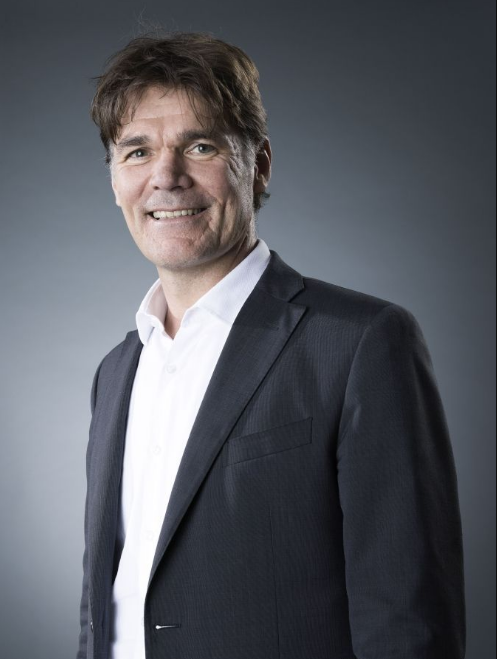
Dr. Paul Depla
Twitter Paul Depla (@PaulDepla)
calling from abroad
telephone number: 14 076+31 76 529 30 01
Email: contact@breda.nl
Post
Municipality of Breda, PO Box 90156, 4800 RH Breda
Twitter: Gemeente Breda
@breda
Facebook:
Gemeente Breda
@gem.Breda
https://www.breda.nl/
